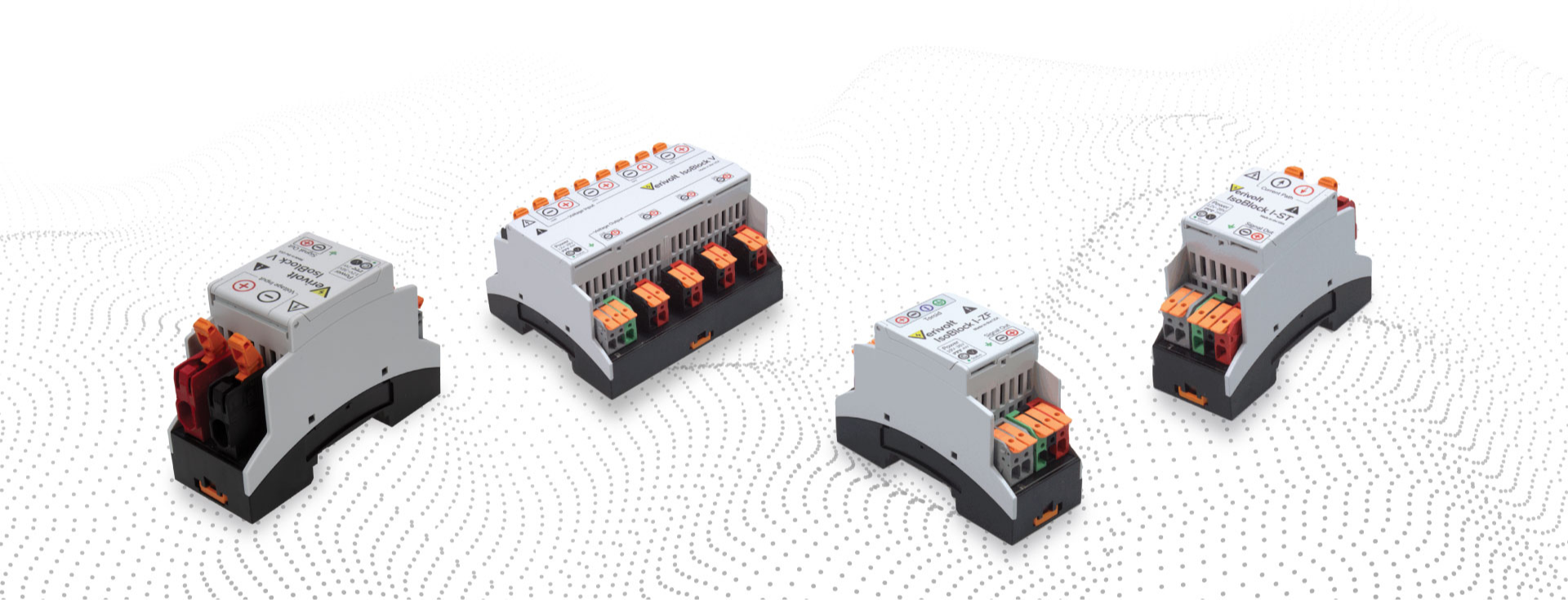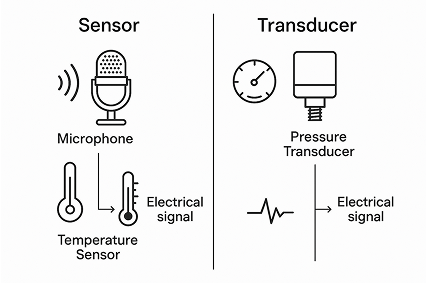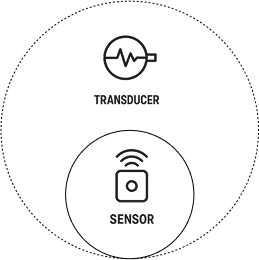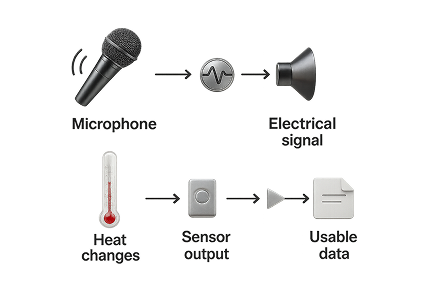Blog Summary
Let's be real—when it comes to the terms “sensor” and “transducer,” most of us get them tangled up from time to time! Here's the simplest way to understand it: all sensors are transducers, but not all transducers are sensors.
Picture this: you're designing a cutting-edge IoT device, and your team debates whether to specify a "sensor" or "transducer" in the technical documentation. This seemingly simple choice reveals a fundamental concept that every electrical engineer must master. While these terms often intermingle in casual conversation, their precise definitions illuminate the hierarchy of measurement systems that power our interconnected world.
The Fundamental Distinction
Let's be real—when it comes to the terms “sensor” and “transducer,” most of us get them tangled up from time to time! The truth is, these words are so closely linked in both engineering jargon and real-world applications that their meanings often overlap. So, if you've ever mixed them up or felt uncertain about which is which, relax—you're right where you belong. In a fast-moving industry, the lines blur, and that's okay. The key isn't having labels perfectly memorized, but understanding how these incredible devices actually work... and that's exactly what we'll clarify together, step by step, right now.
Here's the simplest way to understand it: all sensors are transducers, but not all transducers are sensors.A sensor is like a detective – it detects physical phenomena such as temperature, pressure, or vibration and converts them into measurable electrical signals. A transducer, meanwhile, is more like a translator – it converts energy from one form to another, such as converting mechanical energy into electrical signals or sound waves into electrical currents.
Think of a microphone at a rock concert. The microphone (a transducer) doesn't just detect sound waves; it converts them into electrical signals that can be amplified through speakers. Conversely, a simple temperature sensor might detect heat changes but needs additional circuitry to convert that detection into usable data. As noted by Global Electronic Services, "a sensor senses and a transducer converts."
In today's smart manufacturing landscape, this distinction matters enormously. Self-powered sensors can now harvest energy from magnetic fields around electrical wires – essentially creating transducers that power themselves while monitoring equipment health. These innovations are revolutionizing predictive maintenance, with IoT-enabled sensors reducing manufacturing downtime by up to 30%.
The Technology Behind the Magic
The technical elegance lies in the details. Sensors typically produce analog signals requiring external power and signal conditioning. Transducers, however, complete the entire conversion process. A strain gauge pressure transducer, for instance, uses piezoresistive materials that change resistance under stress, providing output signals typically ranging from 1.5 to 10 mV/V (millivolts per volt of excitation), which are then amplified to standard industrial outputs like 0-5V, 0-10V, or 4-20mA.
Verivolt's IsoBand V series exemplifies this sophisticated engineering approach. These voltage transducers provide three-way galvanic isolation (channel-to-channel, primary-to-secondary, and signal-to-power) while maintaining bandwidth from DC to 8MHz, covering input ranges from ±5V to ±2000V with linear scaling to standard ±10V outputs. This proprietary digital technology enables the highest bandwidth performance available in isolated voltage transducers.
The key distinction lies in their primary functions: sensors detect and measure specific inputs like temperature or pressure, while transducers focus on energy conversion between different forms.
Current transducers are particularly crucial in industrial processes and manufacturing applications due to their high requirement for reliable operations. They help measure and monitor current safely and reliably, preventing overloads while analyzing energy consumption to ensure equipment reliability and reduce expensive downtime.
Whether you need precise pressure transducers for quality control or comprehensive sensor networks for predictive maintenance, understanding these fundamental technologies empowers smarter decisions. At Verivolt, we specialize in integrating cutting-edge sensor and transducer technologies that transform your manufacturing capabilities.
References
Elmenreich, Wilfried, and Stefan Pitzek. “Smart Transducers - Principles, Communications, and Configuration.” Institut für Technische Informatik, Technische Universität Wien, 2003.
https://mobile.aau.at/~welmenre/papers/elmenreich_Smart_Transducers_Principles_Communications_and_Configuration.pdf..
Lee, Kang. “IEEE 1451: A Standard in Support of Smart Transducer Networking.” Proceedings of the 2000 IEEE Instrumentation and Measurement Technology Conference, Baltimore, MD, 2000.
https://webpages.charlotte.edu/~imconrad/ECGR6185-2010-01/readings/Bian_IEEE%201451%20A%20Standard%20in%20Support%20of%20Smart%20Transducer%20Networking.pdf..
Sajid, Memoon, Jahan Zeb Gul, and Kyung Hyun Choi. “Selection of Sensors, Transducers, and Actuators.” In Functional Reverse Engineering of Strategic and Non-Strategic Machine Tools, edited by Wasim Ahmed Khan et al. Boca Raton: CRC Press, 2021.
https://www.taylorfrancis.com/chapters/edit/10.1201/9780429022876-3/selection-sensors-transducers-actuators-memoon-sajid-jahan-zeb-gul-kyung-hyun-choi..
IEEE Standards Association. “IEEE 1451.4-2004 - IEEE Standard for A Smart Transducer Interface for Sensors and Actuators.” Institute of Electrical and Electronics Engineers, 2004.https://standards.ieee.org/wp-content/uploads/import/documents/tutorials/1451d4.pdf..
Silva, Luis C., et al. “Development of an IEEE 1451 Plug-and-Play Module for Smart Transducers in Industrial Environments.” Sensors 22, no. 21 (2022): 8107.
https://pmc.ncbi.nlm.nih.gov/articles/PMC9609107/..




